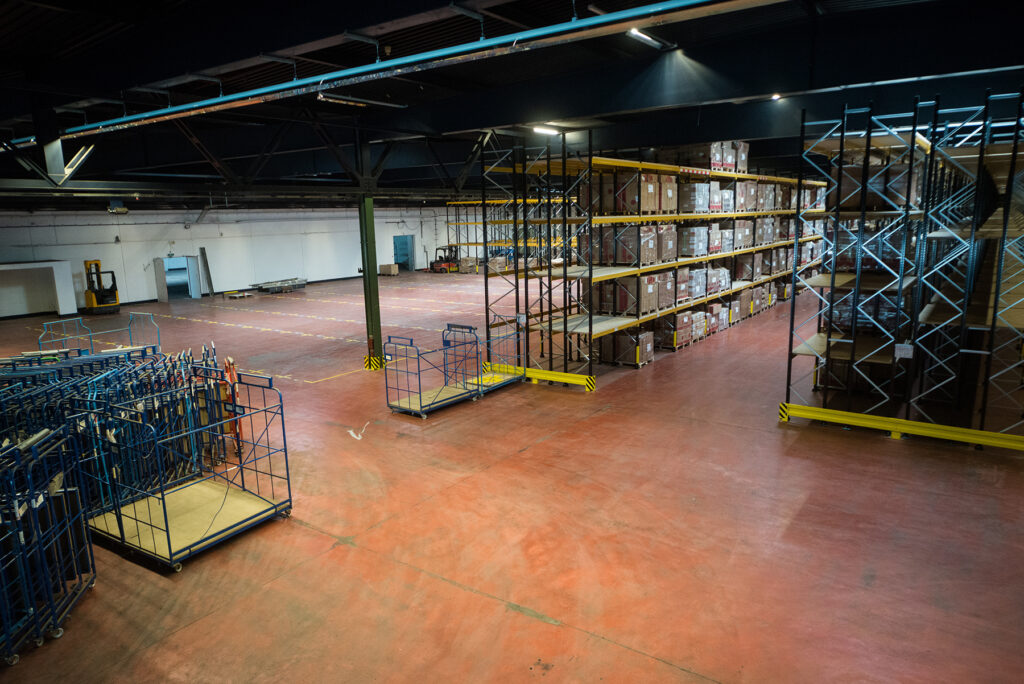Key takeaways you will find in this article
- •Colleges and universities are dealing with a variety of shortages due to supply chain issues, dealing with everything from computer parts to paper goods and construction materials.
- •Not only are these supply shortages inconvenient, but they can also be costly, impact student performance, and cut into teaching time or research opportunities.
- •By tracking supplies ahead of time with inventory tracking software, colleges and universities grant themselves more time between orders, combatting the supply chain shortage.
Table of contents
It’s no secret that higher education institutions have been grappling with significant challenges in recent years. After COVID swept across the globe, it changed learning environments, but it also impacted the supply chains that enable those institutions to operate as they do.

While many things have returned to “normal” now that the pandemic is behind us, it has left one notable, lasting change—the shortage of equipment and supplies.
This shortage can include anything from lumber to food, computers, and facility parts and equipment. Needless to say, a shortage of any of these supplies can hinder the quality of education and research, making it crucial for institutions to find immediate solutions.
In this blog, we will explore the issues that colleges and universities currently face due to this shortage, why efficient tracking of supplies is essential, and how inventory management systems can be a game-changer in addressing these challenges.
Understanding the supply chain shortage
When we talk about a supply shortage, we’re referring to the global supply chain of networks between companies and their suppliers. Those suppliers are responsible for gathering the materials needed to create these in-demand products, and if the suppliers slow down, so does production.
According to Morningstar, “Massive supply chain shortages emerged in the wake of pandemic lockdowns that shut businesses around the world and kept workers at home.”
J.P. Morgan explains the current situation as a global concern:
“Supply chain problems were prominent during the COVID-19 lockdown amid a ‘perfect storm’ of causes, including shifts in demand, labor shortages and structural factors. The Russia-Ukraine conflict and COVID-19 lockdowns in China have recently exacerbated issues, affecting supply in certain sectors including consumer goods, metals, food, chemicals and commodities.”
Simply put, we’re dealing with a domino effect. Many industries and institutions are feeling the impact, and colleges and universities are no exception.
What shortages are higher education institutions facing?
Depending on your school and size, you might be dealing with a variety of shortage issues.
Here are some examples:
- The University of Pittsburgh dealt with a computer hardware shortage. According to their website, they had a limited inventory of laptops, printers, and monitors, causing a several-month delay where students waited for their supplies. This shortage also impacted wireless access points and advanced network equipment for research computing.
- The University of Houston faced food and paper goods shortages caused by supply issues and transportation delays. As a result, students had limited access to vending machine snacks on campus, and costs rose as the school made an effort to expedite necessities.
- Colorado State University is having trouble sourcing supplies for items needed for construction, renovations, and other improvement projects, specifically those dealing with mechanical, audiovisual, engineering, and professional design fields.
Whether your institution is dealing with one of these shortages or one of another kind, these roadblocks can have serious repercussions, both for students and the institutions at large.
10 problems with supply shortages in higher ed
Not only are these supply shortages inconvenient for colleges and universities, but they can also be costly, impact student performance, and cut into teaching time or research opportunities. Specific issues include:
1. Delayed equipment procurement
Colleges and universities often face delays in acquiring essential equipment and supplies due to disruptions in the supply chain. This delay can affect research projects, classroom activities, and the overall quality of education.
2. Budget constraints
Supply chain shortages can lead to increased costs for acquiring equipment and supplies once they are available. Oftentimes, institutions pay extra for rushed shipping or pay a premium for the limited inventory available. Institutions may need to reallocate budgets from other areas, potentially impacting academic programs and staffing.
3. Inadequate technology resources
The shortage of technology-related equipment, such as laptops and tablets, can hinder the transition to online learning and remote work. Students and faculty may struggle with outdated or insufficient technology, which would counteract any educational initiatives toward remote learning.
4. Reduced research capabilities
Research universities may experience setbacks in their research projects due to the unavailability of specialized equipment and materials. This can hinder scientific advancements and innovation, lead to limited lab access, and may hinder hands-on learning and experimentation.
5. Disrupted course schedules
Colleges may need to modify course schedules or cancel classes due to the unavailability of necessary supplies or equipment. This disrupts students’ academic progress and degree completion timelines.
6. Maintenance and repair delays
The shortage of spare parts and maintenance materials can lead to delays in repairing and maintaining equipment. This results in increased downtime, potential safety hazards, and might lead to avoidable equipment replacements.
7. Competitive disadvantage
Institutions facing chronic supply chain shortages may struggle to attract students and faculty. Students may choose institutions with better access to resources.
8. Resource redistribution challenges
Institutions may need to redistribute existing equipment and supplies, causing logistical challenges. This process can lead to conflicts over resource allocation among departments.
9. Compliance and accreditation risks
Supply chain shortages may lead to difficulties in meeting compliance and accreditation standards, especially if shortages impact equipment performance. Failure to provide necessary resources can jeopardize institutional accreditation.
10. Safety concerns
In cases of emergencies or unexpected events, institutions may lack the necessary supplies and equipment to respond effectively. This can compromise the safety and well-being of students and staff.
The concerns that flow from supply shortages can be extensive and impactful, which is why its important to address concerns swiftly. By nature, many of the supply issues might be outside of your control, but there may be other measures you can take to act proactively and stave off more serious consequences.
Using efficient tracking to combat shortages
When it comes to taking charge during the supply shortage, being proactive is key. By tracking your supplies ahead of time, you allow yourself more time between the time you order and when stock runs out.
But tracking can be beneficial for more than just supplies. You might also track commonly replaced parts or equipment, that way you’re able to keep economical options on hand for common breaks or replacements.
The benefits of supply tracking include:
- Resource allocation: Not only can tracking help institutions allocate resources judiciously, but by knowing exactly what they have and how it’s being used, colleges and universities can make informed decisions about when and where to invest.
- Cost reduction: Effective tracking can lead to cost savings. Institutions can avoid overstocking or buying unnecessary equipment and supplies, reducing waste and optimizing their budgets.
- Maintenance and repair: Regular tracking allows institutions to schedule maintenance and repairs promptly, extending the lifespan of expensive equipment and ensuring it remains in optimal working condition.
- Compliance and reporting: Many higher education institutions are required to adhere to specific compliance standards. Efficient tracking simplifies compliance reporting and ensures adherence to regulations.
There are several ways you might opt to track your institution’s supplies, but if you’re interested in maximum oversight and efficiency, you might explore an inventory and supply management solution.
How to track inventory and supplies
Implementing an effective inventory management system is the key to addressing the equipment and supply shortage in higher education. Some schools use digital inventory management software, sometimes alongside barcoding or RFID technology tags to track supplies directly.
Utilizing a centralized database might also help your school contain detailed information about each item in your inventory, including purchase date, location, condition, and maintenance history. These databases might live in dedicated software, through an online system, or on a Google document. While the latter isn’t the most advanced option, it can benefit smaller institutions or those just beginning to track inventory to gain insight.
Whatever your current situation, taking another step forward to fine-tune your system can help advance your institution’s inventory management. For a comprehensive solution, consider inventory management software.
FMX can help counteract supply shortage issues
As colleges and universities continue to face budget constraints and supply chain disruptions, investing in efficient tracking mechanisms becomes not just a strategic choice but a necessity for long-term sustainability and success in higher education. FMX can help.
FMX inventory management software streamlines the tracking and maintenance of supplies, equipment, and resources. Our user-friendly interface allows staff to effortlessly monitor stock levels, schedule maintenance, and optimize resource allocation.
With real-time data at their fingertips, colleges and universities can make informed decisions, preventing waste and reducing costs. FMX also offers barcode scanning and automated alerts, which enhance accountability and prevent loss or theft of valuable assets.
By implementing FMX inventory management software, educational institutions can maximize the value of their resources, ensuring that students and faculty have access to the tools they need for a successful learning experience.
Interested in learning more about FMX’s inventory management software for colleges and universities? We’re here to help. Book a demo today!
Written by
Dana Grove
Manager, Brand and Content at FMX
